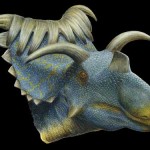
An early predator has been discovered in South America. Image: Todd Marshall
A predator that roamed South America 230 million years ago has been discovered in a dinosaur graveyard.
The new dinosaur was discovered by a team of geologists and palaeontologists from the US and Argentina. It is believed to have weighed between 10 and 15 pounds (4.5 to 6.8 kilograms), with grasping clawed hands and canine teeth, and has been named Eodromaeus (the “˜dawn runner’).
Paul Sereno, University of Chicago palaeontologist and National Geographic Explorer-in-Residence, said in the press release that this is the earliest look at a line predators that would culminate in Tyrannosaurus rex. “Who could foretell what evolution had in store for the descendants of this pint-sized, fleet-footed predator?”
The near- complete skeleton of the new species was discovered in the “˜Valley of the Moon’, a dinosaur graveyard in the foothills of the Andes which provides palaeontologists with a view of the birth of dinosaurs and their evolution. According to Ricardo Martinez, from the National University of San Juan (Argentina), “With a hike across the valley, you literally walk over the graveyard of the earliest dinosaurs to a time when they ultimately dominate.”
Sediments and ash from the volcanoes associated with this area have covered the skeletons over a period of 5 million years. The volcanic ash layers contain radioactive elements that can be dated to determine the age of the sediments and the skeletons therein.
Eodromaeus was found in one of the oldest layers, alongside Eoraptor- a plant-eating dinosaur whose descendants would include the long-necked sauropods. Eodromaeus is the ancestor of the meat-eating theropods and, further up the evolutionary tree, birds.
“We’re looking at a snapshot of early dinosaur life. Their storied evolutionary careers are just unfolding, but at this point they’re actually quite similar,” Sereno says.






